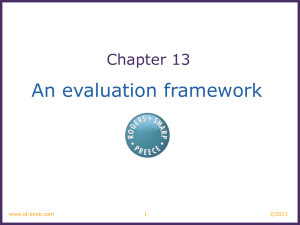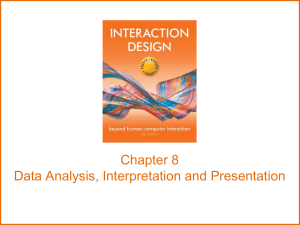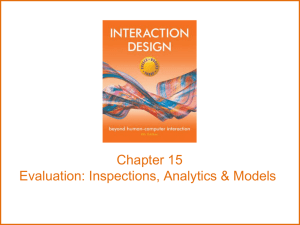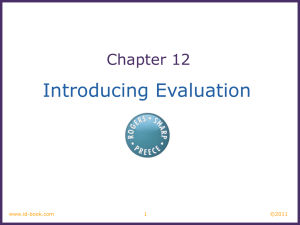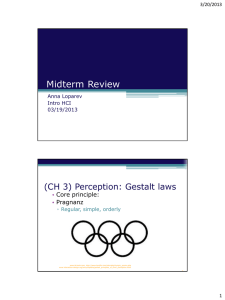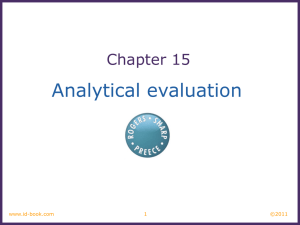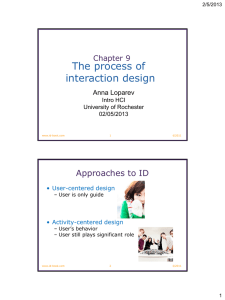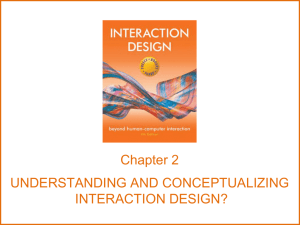chapter7 - Interaction Design
advertisement
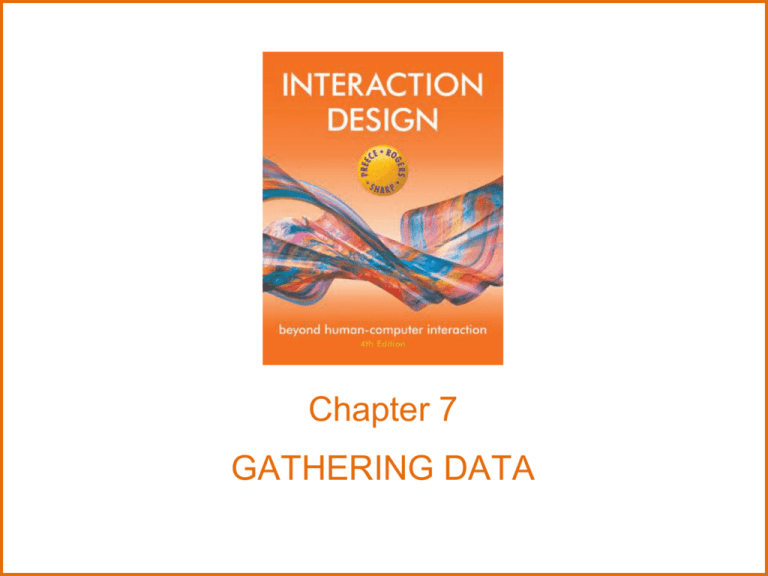
Chapter 7 GATHERING DATA Aims • Discuss how to plan and run a successful data gathering program. • Enable you to plan and run an interview. • Enable you to design a simple questionnaire. • Enable you to plan and carry out an observation. www.id-book.com 2 Five key issues 1. Setting goals • 2. Identifying participants • 3. Clear and professional Informed consent when appropriate Triangulation • • 5. Decide who to gather data from Relationship with participants • • 4. Decide how to analyze data once collected Look at data from more than one perspective Collect more than one type of data, eg qualitative from experiments and qualitative from interviews Pilot studies • Small trial of main study www.id-book.com 3 Data recording • Notes, audio, video, photographs can be used individually or in combination: – Notes plus photographs – Audio plus photographs – Video • Different challenges and advantages with each combination www.id-book.com 4 Interviews • Unstructured - are not directed by a script. Rich but not replicable. • Structured - are tightly scripted, often like a questionnaire. Replicable but may lack richness. • Semi-structured - guided by a script but interesting issues can be explored in more depth. Can provide a good balance between richness and replicability. • Focus groups – a group interview www.id-book.com 5 Interview questions • Two types: − ‘closed questions’ have a predetermined answer format, e.g.. ‘yes’ or ‘no’ − ‘open questions’ do not have a predetermined format • Closed questions are easier to analyze • Avoid: − − − − Long questions Compound sentences - split them into two Jargon and language that the interviewee may not understand Leading questions that make assumptions e.g.. why do you like …? − Unconscious biases e.g.. gender stereotypes www.id-book.com 6 Running the interview • Introduction – introduce yourself, explain the goals of the interview, reassure about the ethical issues, ask to record, present the informed consent form. • Warm-up – make first questions easy and non-threatening. • Main body – present questions in a logical order • A cool-off period – include a few easy questions to defuse tension at the end • Closure – thank interviewee, signal the end, eg. switch recorder off. www.id-book.com 7 Enriching the interview process • Props - devices for prompting interviewee, e.g. use a prototype, scenario www.id-book.com 8 Questionnaires • Questions can be closed or open • Closed questions are easier to analyze, and may be distributed and analyzed by computer • Can be administered to large populations • Disseminated by paper, email and the web • Sampling can be a problem when the size of a population is unknown as is common online evaluation www.id-book.com 9 Questionnaire design • The impact of a question can be influenced by question order. • You may need different versions of the questionnaire for different populations. • Provide clear instructions on how to complete the questionnaire. • Strike a balance between using white space and keeping the questionnaire compact. • Avoid very long questionnaires • Decide on whether phrases will all be positive, all negative or mixed. www.id-book.com 10 Question and response format • ‘Yes’ and ‘No’ checkboxes • Checkboxes that offer many options • Rating scales – Likert scales – semantic scales – 3, 5, 7 or more points • Open-ended responses www.id-book.com 11 Encouraging a good response • Make sure purpose of study is clear • Promise anonymity • Ensure questionnaire is well designed • Offer a short version for those who do not have time to complete a long questionnaire • If mailed, include a stamped addressed envelope • Follow-up with emails, phone calls, letters • Provide an incentive • 40% response rate is good, 20% is often acceptable www.id-book.com 12 Advantages of online questionnaires Relatively easy and quick to distribute Responses are usually received quickly No copying and postage costs Data can be collected in database for analysis Time required for data analysis is reduced Errors can be corrected easily www.id-book.com 13 Example of an online questionnaire www.id-book.com 14 Problems with online questionnaires Sampling is problematic if population size is unknown Preventing individuals from responding more than once can be a problem Individuals have also been known to change questions in email questionnaires www.id-book.com 15 Observation • Direct observation in the field – Structuring frameworks – Degree of participation (insider or outsider) – Ethnography • Direct observation in controlled environments • Indirect observation: tracking users’ activities – Diaries – Interaction logging – Video and photographs collected remotely by drones or other equipment www.id-book.com 16 Observation www.id-book.com 17 Structuring frameworks to guide observation • Three easy-to-remember parts: – The person: Who? – The place: Where? – The thing: What? • A more detailed framework (Robson, 2014): – Space: What is the physical space like and how is it laid out? – Actors: What are the names and relevant details of the people involved? – Activities: What are the actors doing and why? – Objects: What physical objects are present, such as furniture – Acts: What are specifi c individual actions? – Events: Is what you observe part of a special event? – Time: What is the sequence of events? – Goals: What are the actors trying to accomplish? – Feelings: What is the mood of the group and of individuals? www.id-book.com 18 Planning and conducting observation in the field • Decide on how involved you will be: passive observer to active participant • How to gain acceptance • How to handle sensitive topics, eg. culture, private spaces, etc. • How to collect the data: – What data to collect – What equipment to use – When to stop observing www.id-book.com 19 Ethnography (1) Ethnography is a philosophy with a set of techniques that include participant observation and interviews Debate about differences between participant observation and ethnography Ethnographers immerse themselves in the culture that they study A researcher’s degree of participation can vary along a scale from ‘outside’ to ‘inside’ Analyzing video and data logs can be time-consuming Collections of comments, incidents, and artifacts are made www.id-book.com Ethnography (2) • Co-operation of people being observed is required • Informants are useful • Data analysis is continuous • Interpretivist technique • Questions get refined as understanding grows • Reports usually contain examples www.id-book.com 21 Ethnography (2) www.id-book.com 22 Online Ethnography • Virtual, Online, Netnography • Online and offline activity • Interaction online differs from face-to-face • Virtual worlds have a persistence that physical worlds do not have • Ethical considerations and presentation of results are different www.id-book.com 23 Observations and materials that might be collected (Crabtree, 2007) • Activity or job descriptions. • Rules and procedures that govern particular activities. • Descriptions of activities observed. • Recordings of the talk taking place between parties. • Informal interviews with participants explaining the detail of observed activities. • Diagrams of the physical layout, including the position of artifacts. • Other information collected when observing activities: – Photographs of artifacts (documents, diagrams, forms, computers, etc.) – Videos of artifacts. – Descriptions of artifacts. – Workflow diagrams showing the sequential order of tasks. – Process maps showing connections between activities. www.id-book.com 24 Observation in a controlled environment • Direct observation – Think aloud techniques • Indirect observation – tracking users’ activities – Diaries – Interaction logs – Web analytics • Video, audio, photos, notes are used to capture data in both types of observations www.id-book.com 25 Web analytics • A system of tools and techniques for optimizing web usage by: – Measuring, – Collecting, – Analyzing, and – Reporting web data • Typically focus on the number of web visitors and page views. www.id-book.com 26 A section of Google analytics dashboard for id-book.com www.id-book.com 27 Choosing and combining techniques • Depends on the: – Focus of the study – Participants involved – Nature of the technique(s) – Resources available – Time available www.id-book.com 28 Summary • Data gathering sessions should have clear goals. • An informed consent may be needed. • Five key issues of data gathering are: goals, choosing participants, triangulation, participant relationship, pilot. • Data may be recorded using handwritten notes, audio or video recording, a camera, or any combination of these. • Interviews may be structured, semi-structured or unstructured • Focus groups are group interviews • Questionnaires may be on paper, online or telephone • Observation may be direct or indirect, in the field or in controlled settings. • Techniques can be combined depending on the study focus, participants, nature of technique, available resources and time. www.id-book.com 29
